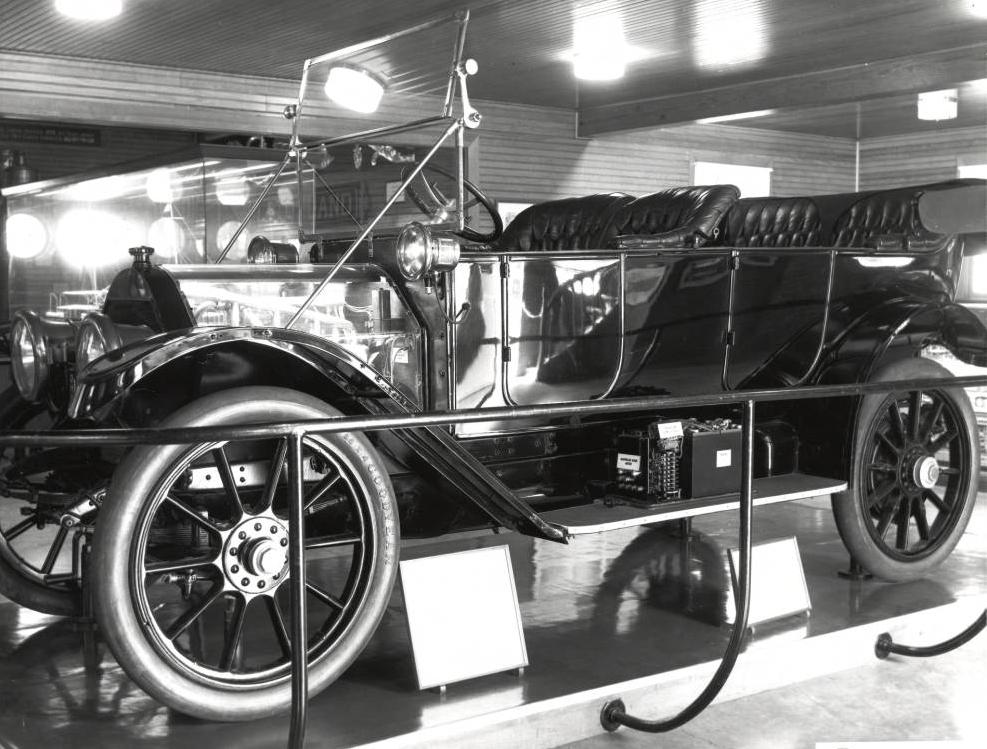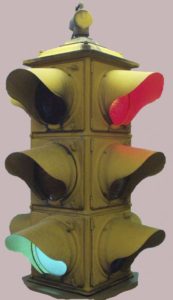The Supreme Creation of an Era: Ohio and the Early Auto Industry

Of Ohio’s many claims to fame, those involving cars are typically not at the top of the list. We are, however, leaders in three areas relating to autos: accidents, signals, and inventors of automobiles and related technologies.
The first traffic accident involving an automobile occurred in 1891 in Ohio City, Ohio. John William Lambert, a native of Champaign County, struck a tree root, swerved, and hit a hitching post. Both he and his passenger, James Swoveland, were injured, though not seriously. At the time of the accident, Lambert was driving a Buckeye Gasoline Buggy, a car of his own invention and the first gas-powered automobile to be available for sale. Lambert marketed his car, essentially a tricycle with a motor, for the price of $550 each. Unfortunately, Lambert was unable to make any sales and manufacture of the cars was discontinued.

Over the course of the next decade, automobile sales increased and cars gained favor as a means of transportation. Roads were clogged with cars, horses and buggies, pedestrians and bicycles, creating a chaotic mass of movement with little direction or regulation, save that of police officers with whistles and signs that said “stop” and “go.” Then came August 5, 1914, and the installation of what is regarded as the first electric traffic signal on the corner of Euclid Avenue and East 105th Street in Cleveland. The signal was developed, and later patented, by Belmont County native and industrialist James Hoge, organizer of the Lorain Savings & Banking Company and one of the builders of the Lorain & Cleveland Railway. Hoge’s manually-operated design featured four pairs of red and green lights configured to eliminate the possibility of conflicting signals.

Despite Hoge’s accomplishment, it is Cleveland resident Garrett Morgan who is widely regarded as the inventor of the traffic signal. His was a t-shaped design and, like the signal created by Hoge, was manually operated. Morgan, a prolific inventor, was the first African American in Cleveland to own an automobile. He was inspired to create his traffic signal after witnessing a serious collision between a car and a horse and buggy at a busy Cleveland intersection. Though traffic signals were not new –– again, Hoge’s signal had already been installed elsewhere in Cleveland –– Morgan’s invention was notable in that it featured a third position that warned drivers to exercise caution and prepare for a signal change. Morgan patented his signal in 1923, and the patent was later sold to General Electric for $40,000. General Electric then altered Morgan’s design and utilized colored lights – red, yellow and green – and created the traffic signals we still use today.
Though only loosely related to traffic, it is worth noting that Ohioan Charles Kettering’s invention of the automobile self-starter in 1911 certainly contributed to increased safety and, very likely, decreased auto accidents. Prior to the development of the electric starter, cranks were used to engage automobile engines. At the time, however, most cars did not have brakes, and could easily backfire or roll forward when the crank was engaged. Kettering had developed the first electric cash register, which featured a push button that opened its drawer. Seeing a clear safety hazard in hand-crank automobile starters, he believed a solution similar to that which he had developed for cash registers was possible. His design, which started automobiles with a key, was introduced in 1912 and revolutionized automobile manufacture.
French linguist and philosopher Roland Barthes said that cars were “the supreme creation of an era, conceived with passion by unknown artists.” Fortunately for us, a number of Ohioans made significant achievements in the automobile and related industries and so “unknown artist” does not apply. Today, when you drive your car, think of these inventors and leaders, and thank them for keeping you safe and moving forward!
Thank you to Shannon Kupfer, Digital Initiatives Librarian at theState Library of Ohio, for this week’s post!



Leave a Reply
You must be logged in to post a comment.